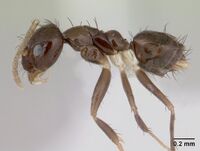Nylanderia steinheili
| Nylanderia steinheili | |
|---|---|

| |
| Scientific classification | |
| Kingdom: | Animalia |
| Phylum: | Arthropoda |
| Class: | Insecta |
| Order: | Hymenoptera |
| Family: | Formicidae |
| Subfamily: | Formicinae |
| Tribe: | Lasiini |
| Genus: | Nylanderia |
| Species: | N. steinheili |
| Binomial name | |
| Nylanderia steinheili (Forel, 1893) | |
| Synonyms | |
| |
| At a Glance | • Invasive |
Identification
LaPolla and Kallal (2019) - Dark brown, contrasting sharply with white trochanters and meso/metacoxae; mesosomal dorsum and gastral tergite 1 with moderate to dense pubescence.
Compare with: Nylanderia guatemalensis
Nylanderia steinheili is a widespread species, which may or may not be native to the West Indies. There is considerable morphological variation in what we are calling N. steinheili. This species is putatively found in Central and South America as well so it is hoped that as revisions of Nylanderia in those regions are completed further data for better refinement of the morphological limits of this species will be possible. Nylanderia steinheili and N. guatemalensis are broadly sympatric across the West Indies with both occurring primarily in similarly disturbed habitats. Usually both can be separated relatively easily based on worker body coloration, with N. steinheili being dark brown to black and N. guatemalensis being yellow to light brown (typically with contrasting dark macrosetae). However, particularly in southern Florida and the Bahamas, N. guatemalensis can have a darker body, sometimes approaching dark brown. This can make distinguishing the species difficult. N. guatemalensis and N. steinheili both occur in Florida in contrast to Kallal and LaPolla (2012) which only reported N. steinheili. Apparently, N. guatemalensis occurs only in the extreme southern part of the state, whereas N. steinheili is more widespread. We found N. guatemalensis workers have a SI above 120 while N. steinheili worker have a SI below 120, but there is some overlap. Like N. steinheili, N. guatemalensis putatively ranges into Central and South America. We did examine the penial sclerites for both N. steinheili and N. guatemalensis males. Overall the penial sclerites are fairly similar in basic structure but there are some importance differences. The anteroventral process of N. steinheili is emarginate, whereas in N. guatemalensis it is broadly rounded. Additionally, the penial sclerite vulvurae are ventrally placed in N. steinheili; in N. guatemalensis they are at the midline of the penial sclerites. As in worker morphology, the male morphology suggests these species are closely related, perhaps even sister taxa. It is important to note we examined a relatively small number of males and both of these species range far outside of the West Indies where male morphology needs to be examined as well.
Identification Keys including this Taxon
Distribution
Latitudinal Distribution Pattern
Latitudinal Range: 20.85574444° to -19.805°.
| North Temperate |
North Subtropical |
Tropical | South Subtropical |
South Temperate |
- Source: AntMaps
Distribution based on Regional Taxon Lists
Malagasy Region: Seychelles.
Nearctic Region: United States.
Neotropical Region: Brazil, Colombia, Costa Rica, Cuba, Dominican Republic, Ecuador, Galapagos Islands, Greater Antilles, Grenada, Guadeloupe, Guatemala, Haiti, Honduras, Lesser Antilles, Mexico, Netherlands Antilles, Panama, Puerto Rico, Trinidad and Tobago, Venezuela.
Distribution based on AntMaps
Distribution based on AntWeb specimens
Check data from AntWeb
Countries Occupied
| Number of countries occupied by this species based on AntWiki Regional Taxon Lists. In general, fewer countries occupied indicates a narrower range, while more countries indicates a more widespread species. |

|
Estimated Abundance
| Relative abundance based on number of AntMaps records per species (this species within the purple bar). Fewer records (to the left) indicates a less abundant/encountered species while more records (to the right) indicates more abundant/encountered species. |

|
Biology
Castes
Worker
   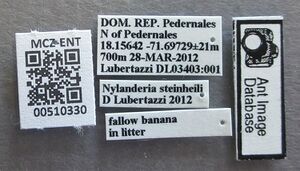    
| |
| . | |
Images from AntWeb
 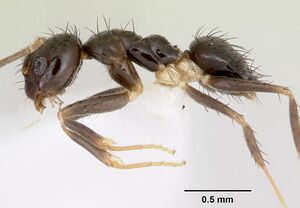 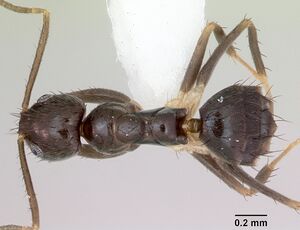 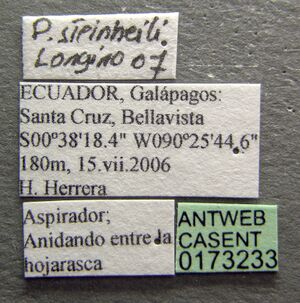
| |
| Worker. Specimen code casent0173233. Photographer April Nobile, uploaded by California Academy of Sciences. | Owned by CDRS, Galapagos, Ecuador. |
   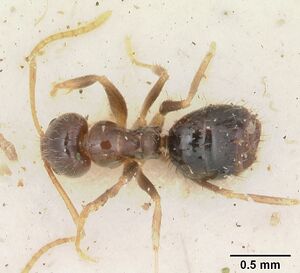 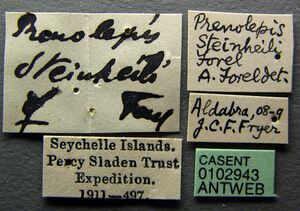
| |
| Worker. Specimen code casent0102943. Photographer April Nobile, uploaded by California Academy of Sciences. | Owned by NHMUK, London, UK. |
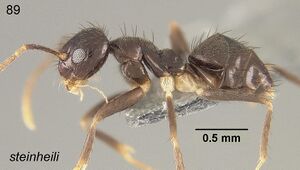  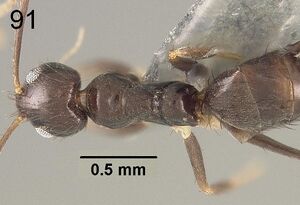
| |
| . | |
Queen
Images from AntWeb
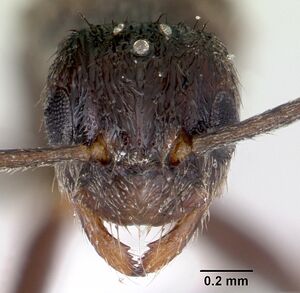   
| |
| Queen (alate/dealate). Specimen code casent0173235. Photographer April Nobile, uploaded by California Academy of Sciences. | Owned by CDRS, Galapagos, Ecuador. |
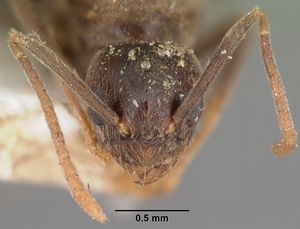   
| |
| Queen (alate/dealate). Specimen code casent0101622. Photographer April Nobile, uploaded by California Academy of Sciences. | Owned by MHNG, Geneva, Switzerland. |
Male
Images from AntWeb
   
| |
| Queen (alate/dealate). Specimen code casent0173234. Photographer April Nobile, uploaded by California Academy of Sciences. | Owned by CDRS, Galapagos, Ecuador. |
   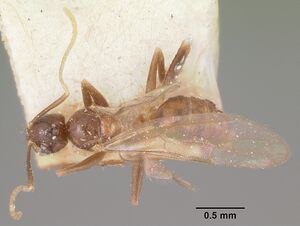 
| |
| Male (alate). Specimen code casent0101675. Photographer April Nobile, uploaded by California Academy of Sciences. | Owned by MHNG, Geneva, Switzerland. |
Nomenclature
The following information is derived from Barry Bolton's Online Catalogue of the Ants of the World.
- steinheili. Prenolepis steinheili Forel, 1893g: 342 (w.) ANTILLES. Forel, 1908b: 64 (q.); Forel, 1912i: 66 (m.). Combination in Pr. (Nylanderia): Forel, 1912i: 66; in Paratrechina (Nylanderia): Emery, 1925b: 223; in Nylanderia: Kempf, 1972a: 168; in Paratrechina: Brandão, 1991: 367; in Nylanderia: LaPolla, Brady & Shattuck, 2010a: 127. Current subspecies: nominal plus minuta (unresolved junior homonym). Senior synonym of minuta: LaPolla & Kallal, 2019: 437.
- minuta. Prenolepis steinheili var. minuta Forel, 1893g: 343 (w.q.m.) ANTILLES.
- [Unresolved junior primary homonym of Prenolepis imparis var. minuta Emery, 1893i: 636 (Bolton, 1995b: 314).]
- Combination in Pr. (Nylanderia): Forel, 1912i: 66; in Paratrechina (Nylanderia): Emery, 1925b: 223; in Nylanderia: Kempf, 1972a: 168; in Paratrechina: Brandão, 1991: 367; in Nylanderia: LaPolla, Brady & Shattuck, 2010a: 127.
- Junior synonym of steineili: LaPolla & Kallal, 2019: 437.
Description
Worker
Reine. L. 2, 1 a 2, 4 mill. Mandibules armees de 6 dents, luisantes, avec quelques stries et quelques points epars. Tete ovale•rectaugulaire, aussi large devant que derriere. Les scapes depassent le bord posterieur de la tete d'1/3 environ de leur longueur. Epistome a peine concave au milieu de son bord anterieur. Thorax assez robuste, profondement echancre entre le mesonotum et le metanotum. L'echancrure est presque aussi large au fond qu'un peu plus haut, c'est a dire qu'elle a au fond une courte surface plus ou moins plane, non pas seulement une simple ligne transversale, et que ses bords s'elevent d'une facon abrupte, subverticale, tant vers le mesonotum que vers le metanotum. Au fond de l'echancrure sont deux stigmates presque aussi gros que l'intervalle qui les separe l'un de l'autre. La metanotum est en bosse arrondie et presque aussi eleve que le mesonotum; sa face basale est un peu plus courte que sa face declive dont on peut a peine la distinguer.
Ecaille, face declive du metanotum, cotes du thorax, epistome et parfois une partie du pronotum lisses, luisants, et glabres. Le reste ponctue, mediocrement pubescent et subopaque.
Les soies dressees ont la repartition ordinair6 sur le corps, les pattes et les antennes. Elles sont plus epaisses et plus obtuses que chez les formes precedentes, d'un brun noiratre.
D'un noir brun on parfois d'un brun noir. Thorax et pedicule souvent d'un brun plus clair. Antennes, mandibules et pattes brunates. Tarses, articulations des pattes, hanches et anncaux femoraux d'un jaune tres pale, parfois meme blanchatre. La taille varie tres peu.
LaPolla and Kallal (2019) - (n=12): TL:1.70–2.30; HW: 0.49–0.57; HL: 0.57–0.67; EL: 0.14–0.19; SL: 0.63– 0.84; WL: 0.71–0.88; GL: 0.69–0.96. SMC: 12–23; PMC: 2–4; MMC: 2–3. indices: CI: 81–91; REL: 22–30; SI: 118–155; SI2: 17–24.
Head: sides of head in full face view nearly parallel to rounded; posterolateral corners rounded; posterior margin straight, sometimes slightly emarginate medially; anterior clypeal margin nearly straight to slightly emarginate; median ocellus sometimes present; eyes well-developed. Mesosoma: in lateral view, pronotum convex; anterior margin of mesonotum raised slightly above posterior pronotal margin; metanotal area without short flat area before spiracle; dorsal face of propodeum slightly convex; dorsal face of propodeum and mesonotum approximately the same height or propodeum slightly lower than mesonotum in lateral view. Color and pilosity: body dark brown, trochanters, mesocoxa and metacoxae white; antennae and mandible lighter brown than head, mesosoma and gaster; pubescence abundant across body except mesopleuron and lateral portions of pronotum which are without pubescence.
Queen
LaPolla and Kallal (2019) - (n=3): TL: 3.20–3.40; HW: 0.73–0.78; HL: 0.73–0.78; EL: 0.23–0.24; SL: 0.79–0.89; WL: 1.20–1.30; GL: 1.50–1.80. SMC: 10–12; PMC: 3–6; MMC: 11–12. indices: CI: 99–105; REL: 31–33; SI: 107–119.
Generally, as in worker with modifications expected for caste.
Male
LaPolla and Kallal (2019) - (n=3): TL: 1.70–1.96; HW: 0.52–0.53; HL: 0.50–0.52; EL: 0.19–0.20; SL: 0.62–0.71; WL: 0.75–0.80; GL: 0.70–0.80. SMC: 8–14; PMC: 0; MMC: 10–16. indices: CI: 99–106; REL: 37–39; SI: 119– 133.
Head: sides of head in full face view rounded; posterior margin rounded; clypeus nearly straight anteriorly; mandible with distinct apical tooth and much smaller, often indistinct, subapical tooth adjacent to apical tooth; basal angle indistinct. Mesosoma: in lateral view, dorsal margin of mesoscutum same as height as dorsal margin of mesoscutellum; propodeum steeply sloping without distinct dorsal and declivitous faces. Genitalia: gonopod apex coming to triangular point in lateral view; gonopod margin in dorsal view curves away from penial sclerite; digitus with pointed apex that bends away from penial sclerite; cuspis tubular, rounded at apex bending sharply toward digitus; anteroventral process of penial sclerite coming to point with ventral margin of process emarginate; valvura of penial sclerite placed ventral to midline (fig. 105). Color and pilosity: body typically dark brown with contrasting yellow-white to yellowish-brown (typically not as light as in workers) trochanters, and mesocoxa and metacoxa; antenna and mandible lighter brown than head, mesosoma and gaster; pubescence abundant across body except on mesopleuron which is without pubescence.
Type Material
Antille de St. Thomas (moi-meme), Guatemala (Dr. Stoll).
LaPolla and Kallal (2019) - Lectotype worker, ST. THOMAS, Antilles, 13.X.78 (examined) (Musee d'Histoire Naturelle Genève). Lectotype designated by Trager, 1984.
References
- Albuquerque, E., Prado, L., Andrade-Silva, J., Siqueira, E., Sampaio, K., Alves, D., Brandão, C., Andrade, P., Feitosa, R., Koch, E., Delabie, J., Fernandes, I., Baccaro, F., Souza, J., Almeida, R., Silva, R. 2021. Ants of the State of Pará, Brazil: a historical and comprehensive dataset of a key biodiversity hotspot in the Amazon Basin. Zootaxa 5001, 1–83 (doi:10.11646/zootaxa.5001.1.1).
- Brandão, C. R. F. 1991. Adendos ao catálogo abreviado das formigas da região Neotropical (Hymenoptera: Formicidae). Rev. Bras. Entomol. 35: 319-412 (page 367, Combination in Paratrechina)
- Conceição-Neto, R., França, E.C.B., Feitosa, R.M., Queiroz, J.M. 2021. Revisiting the ideas of trees as templates and the competition paradigm in pairwise analyses of ground-dwelling ant species occurrences in a tropical forest. Revista Brasileira de Entomologia 65, e20200026 (doi:10.1590/1806-9665-rbent-2020-0026).
- Emery, C. 1925d. Hymenoptera. Fam. Formicidae. Subfam. Formicinae. Genera Insectorum 183: 1-302 (page 223, Combination in Paratrechina (Nylanderia))
- Forel, A. 1893j. Formicides de l'Antille St. Vincent, récoltées par Mons. H. H. Smith. Trans. Entomol. Soc. Lond. 1893: 333-418 (page 342, worker described)
- Forel, A. 1908a. Catálogo systemático da collecça~o de formigas do Ceará. Bol. Mus. Rocha 1(1 1: 62-69 (page 64, queen described)
- Forel, A. 1912j. Formicides néotropiques. Part VI. 5me sous-famille Camponotinae Forel. Mém. Soc. Entomol. Belg. 20: 59-92 (page 66, male described, combination in Pr. (Nylanderia))
- Franco, W., Ladino, N., Delabie, J.H.C., Dejean, A., Orivel, J., Fichaux, M., Groc, S., Leponce, M., Feitosa, R.M. 2019. First checklist of the ants (Hymenoptera: Formicidae) of French Guiana. Zootaxa 4674, 509–543 (doi:10.11646/zootaxa.4674.5.2).
- Herrera, H.W., Baert, L., Dekoninck, W., Causton, C.E., Sevilla, C.R., Pozo, P., Hendrickx, F. 2020. Distribution and habitat preferences of Galápagos ants (Hymenoptera: Formicidae). Belgian Journal of Entomology, 93: 1–60.
- Kallal, R.J. & LaPolla, J.S. 2012. Monograph of Nylanderia (Hymenoptera: Formicidae) of the World, Part II: Nylanderia in the Nearctic. Zootaxa 3508, 1-64.
- Kempf, W. W. 1972b. Catálogo abreviado das formigas da regia~o Neotropical. Stud. Entomol. 15: 3-344 (page 168, Combination in Nylanderia)
- Landero-Torres, I., Garcia-Martinez, M.A., Galindo-Tovar, M.E., Leyva-Ovalle, O.R., Lee-Espinosa, H.E., Murguia-Gonzalez, J., Negrin-Ruiz, J. 2014. Alpha diversity of the myrmecofauna of the Natural Protected Area Metlac from Fortin, Veracruz, Mexico. Southwestern Entomologist 39: 541-553.
- LaPolla, J.S., Kallal, R.J. 2019. Nylanderia of the World Part III: Nylanderia in the West Indies. Zootaxa 4658 (3): 401–451 (doi:10.11646/zootaxa.4658.3.1).
- Lubertazzi, D. 2019. The ants of Hispaniola. Bulletin of the Museum of Comparative Zoology, 162(2), 59-210 (doi:10.3099/mcz-43.1).
- Meurgey, F. 2020. Challenging the Wallacean shortfall: A total assessment of insect diversity on Guadeloupe (French West Indies), a checklist and bibliography. Insecta Mundi 786: 1–183.
- Reyes, J.L. 2010. Apuntes sobre una comunidad de hormigas sinantrópicas en Santiago de Cuba (Hymenoptera: Formicidae). Cocuyo 18: 44-47.
- Wetterer, J.K. 2021. Ants (Hymenoptera, Formicidae) of St. Vincent, West Indies. Sociobiology 68, e6725 (doi:10.13102/sociobiology.v68i2.6725).
- Wheeler, W. M. 1922k. Ants of the American Museum Congo expedition. A contribution to the myrmecology of Africa. IX. A synonymic list of the ants of the Malagasy region. Bull. Am. Mus. Nat. Hist. 4 45: 1005-1055 (see also)
- Williams, J.L., Zhang, Y.M., LaPolla, J.S., Schultz, T.R., Lucky, A. 2022. Phylogenetic delimitation of morphologically cryptic species in globetrotting Nylanderia (Hymenoptera: Formicidae) species complexes. Insect Systematics and Diversity 6 (1): 10:1-15 (doi:10.1093/isd/iaxb027).
- Williams, J.L., Zhang, Y.M., Lloyd, M.W., LaPolla, J.S., Schultz, T.R., Lucky, A. 2020. Global domination by crazy ants: phylogenomics reveals biogeographical history and invasive species relationships in the genus Nylanderia (Hymenoptera: Formicidae). Systematic Entomology 45, 730–744 (doi:10.1111/syen.12423).
References based on Global Ant Biodiversity Informatics
- Achury R., and A.V. Suarez. 2017. Richness and composition of ground-dwelling ants in tropical rainforest and surrounding landscapes in the Colombian Inter-Andean valley. Neotropical Entomology https://doi.org/10.1007/s13744-017-0565-4
- Adams B. J., S. A. Schnitzer, and S. P. Yanoviak. 2016. Trees as islands: canopy ant species richness increases with the size of liana-free trees in a Neotropical forest. Ecography doi: 10.1111/ecog.02608
- Adams B. J., S. A. Schnitzer, and S. P. Yanoviak. 2019. Connectivity explains local ant community structure in a Neotropical forest canopy: a large-scale experimental approach. Ecology 100(6): e02673.
- Ahuatzin D. A., E. J. Corro, A. Aguirre Jaimes, J. E. Valenzuela Gonzalez, R. Machado Feitosa, M. Cezar Ribeiro, J. Carlos Lopez Acosta, R. Coates, W. Dattilo. 2019. Forest cover drives leaf litter ant diversity in primary rainforest remnants within human-modified tropical landscapes. Biodiversity and Conservation 28(5): 1091-1107.
- Castano-Meneses, G., M. Vasquez-Bolanos, J. L. Navarrete-Heredia, G. A. Quiroz-Rocha, and I. Alcala-Martinez. 2015. Avances de Formicidae de Mexico. Universidad Nacional Autonoma de Mexico.
- Dattilo W. et al. 2019. MEXICO ANTS: incidence and abundance along the Nearctic-Neotropical interface. Ecology https://doi.org/10.1002/ecy.2944
- Dejean, A., S. Durou, I. Olmsted, R.R. Snelling and J. Orivel. 2003. Nest Site Selection by Ants in a Flooded Mexican Mangrove, with Special Reference to the Epiphytic Orchid Myrmecophila christinae. Journal of Tropical Ecology 19(3) :325-331
- Dejean, A., S. Durou, I. Olmsted, R.R. Snelling and J. Orivel. 2003. Nest Site Selection by Ants in a Flooded Mexican Mangrove, with Special Reference to the Epiphytic Orchid Myrmecophila christinae. Journal of Tropical Ecology 19(3):325-331
- Del Toro, I., M. Vazquez, W. Mackay, P. Rojas, and R. Zapata-Mata. "Hormigas (Hymenoptera: Formicidae) de Tabasco: explorando la diversidad de la mirmecofauna en las selvas tropicales de baja altitud." Dugesiana 16, no. 1 (2009): 1-14.
- Del Toro, I., M. Vázquez, W.P. Mackay, P. Rojas and R. Zapata-Mata. Hormigas (Hymenoptera: Formicidae) de Tabasco: explorando la diversidad de la mirmecofauna en las selvas tropicales de baja altitud. Dugesiana 16(1):1-14.
- Fernandes, P.R. XXXX. Los hormigas del suelo en Mexico: Diversidad, distribucion e importancia (Hymenoptera: Formicidae).
- Fernández F., E. E. Palacio, W. P. Mackay, and E. S. MacKay. 1996. Introducción al estudio de las hormigas (Hymenoptera: Formicidae) de Colombia. Pp. 349-412 in: Andrade M. G., G. Amat García, and F. Fernández. (eds.) 1996. Insectos de Colombia. Estudios escogidos. Bogotá: Academia Colombiana de Ciencias Exactas, Físicas y Naturales, 541 pp
- Fernández, F. and S. Sendoya. 2004. Lista de las hormigas neotropicales. Biota Colombiana Volume 5, Number 1.
- Franco W., N. Ladino, J. H. C. Delabie, A. Dejean, J. Orivel, M. Fichaux, S. Groc, M. Leponce, and R. M. Feitosa. 2019. First checklist of the ants (Hymenoptera: Formicidae) of French Guiana. Zootaxa 4674(5): 509-543.
- Kempf, W.W. 1972. Catalago abreviado das formigas da regiao Neotropical (Hym. Formicidae) Studia Entomologica 15(1-4).
- LaPolla J. S., and R. J. Kallal. 2019. Nylanderia of the World Part III: Nylanderia in the West Indies. Zootaxa 4658: 401-451.
- Longino J. T. 2013. Ants of Nicargua. Consulted on 18 Jan 2013. https://sites.google.com/site/longinollama/reports/ants-of-nicaragua
- Longino J. et al. ADMAC project. Accessed on March 24th 2017 at https://sites.google.com/site/admacsite/
- Lopes M. C., G. P. A. Lamarre, C. Baraloto, P. V. A. Fine, A. Vincentini, and F. B. Baccaro. 2019. The Amazonas-trap: a new method for sampling plant-inhabiting arthropod communities in tropical forest understory. Entomologia Experimentalis et Applicata https://doi.org/10.1111/eea.12797
- Maes, J.-M. and W.P. MacKay. 1993. Catalogo de las hormigas (Hymenoptera: Formicidae) de Nicaragua. Revista Nicaraguense de Entomologia 23.
- Ottonetti L., L. Tucci, F. Frizzi, G. Chelazzi, and G. Santini. 2010. Changes in ground-foraging ant assemblages along a disturbance gradient in a tropical agricultural landscape. Ethology Ecology & Evolution 22: 7386.
- Philpott, S.M., P. Bichier, R. Rice, and R. Greenberg. 2007. Field testing ecological and economic benefits of coffee certification programs. Conservation Biology 21: 975-985.
- Reynoso-Campos J. J., J. A. Rodriguez-Garza, and M. Vasquez-Bolanos. 2015. Hormigas (Hymenoptera: Formicidae) de la Isla Cozumel, Quintana Roo, Mexico (pp. 27-39). En: Castaño Meneses G., M. Vásquez-Bolaños, J. L. Navarrete-Heredia, G. A. Quiroz-Rocha e I. Alcalá-Martínez (Coords.). Avances de Formicidae de México. UNAM, Universiad de Guadalajara, Guadalajara, Jalisco.
- Sandoval V. E., and G. Zambrano. 2007. Catálogo de las hormigas presentes en el Museo de Historia Natural de la Universidad del Cauca. Taller Editorial de la Universidad del Cauca, Popayán. 60 pp.
- Saporito, R.A., H. M. Garraffo, M.A. Donnelly, A.L. Edwards, J.T. Longion and J.W. Daly. 2004. Formicine Ants: An Arthropod Source for the Pumiliotoxin Alkaloids of Dendrobatid Poison Frogs. Proceedings of the National Academy of Sciences of the United States of America 101(21):8045-8050
- Siqueira de Castro F., A. B. Gontijo, P. de Tarso Amorim Castro, and S. Pontes Ribeiro. 2012. Annual and Seasonal Changes in the Structure of Litter-Dwelling Ant Assemblages (Hymenoptera: Formicidae) in Atlantic Semideciduous Forests. Psyche doi:10.1155/2012/959715
- Torres, I. L., M. A. G. Martinez, H. O. Rivera, M. E. G. Tovar, H. E. L. Espinosa, and J. M. Gonzalez. 2018. Comparacion de dos muestreos de hormigas del suelo en la barranca de Metlac, Fortin de las Flores, Veracruz, Mexico. Revista Cientifica UDO Agricola 10: 173-178.
- Vásquez-Bolaños M. 2011. Lista de especies de hormigas (Hymenoptera: Formicidae) para México. Dugesiana 18: 95-133
- Wheeler W. M. 1922. The ants of Trinidad. American Museum Novitates 45: 1-16.
